Understanding Visa Options for Migrants in the United States
Introduction to U.S. Visa Options
For individuals considering migrating to the United States, understanding the available visa options is a crucial step in the process. The U.S. immigration system offers a range of visa categories, each designed to cater to different needs and circumstances. Whether you are planning to work, study, or reunite with family, it is essential to familiarize yourself with the various options to make an informed decision.
The complex nature of U.S. immigration laws can often be daunting. However, with the right guidance, navigating these waters becomes manageable. Below, we explore some of the main visa categories available to migrants looking to enter the United States.

Employment-Based Visas
One of the most common pathways for migrants is through employment-based visas. These visas are usually sponsored by employers and are categorized based on skills, job offers, or investments. The most notable categories include:
- H-1B Visa: For professionals in specialty occupations requiring a bachelor's degree or higher.
- L-1 Visa: For intra-company transferees who work for a multinational company and are being transferred to a U.S. office.
- EB-5 Visa: For investors who contribute a significant amount of capital to a U.S. business venture that creates jobs.
Each of these visas has specific requirements and limitations, making it important for applicants to engage with employers and legal experts during the application process.
Family-Based Visas
Family reunification is a cornerstone of U.S. immigration policy. Family-based visas allow U.S. citizens and lawful permanent residents to sponsor relatives for immigration. These visas are classified into two main categories:
- Immediate Relatives: Spouses, children (under 21), and parents of U.S. citizens.
- Family Preference: Includes adult children and siblings of U.S. citizens, as well as spouses and unmarried children of lawful permanent residents.
The process for family-based visas often involves proving the familial relationship through documentation and can vary in processing times depending on the category.

Student and Exchange Visas
For those looking to pursue educational opportunities in the United States, student and exchange visas provide an avenue for entry. The primary types include:
- F-1 Visa: For academic students enrolled in a program at an accredited U.S. educational institution.
- M-1 Visa: For vocational or non-academic students.
- J-1 Visa: For exchange visitors participating in programs promoting cultural exchange.
These visas typically require evidence of acceptance into an educational program and proof of financial support during the stay in the United States.
Diversity Visa Lottery Program
The Diversity Visa (DV) Lottery Program provides another potential path for immigrants. It aims to diversify the immigrant population in the U.S. by selecting applicants from countries with historically low rates of immigration. Each year, up to 55,000 visas are available through this program.
Applicants are chosen at random through a computer-generated lottery system and must meet simple but strict eligibility requirements, such as having at least a high school education or equivalent work experience.

Navigating the Application Process
The application process for U.S. visas can be lengthy and complex, often requiring detailed documentation and adherence to strict guidelines. It is advisable for prospective migrants to seek assistance from immigration attorneys or accredited representatives who can provide guidance throughout the process.
Staying informed about changes in immigration policy and understanding the specific requirements for each visa type can significantly increase an applicant's chances of success. Taking proactive steps to gather necessary documents and prepare thoroughly can make a substantial difference in the outcome.
Conclusion
Navigating the U.S. visa system requires careful planning and understanding of available options. Whether through employment, family connections, education, or diversity programs, each path offers unique opportunities and challenges. By gaining a comprehensive understanding of these options and seeking professional advice, migrants can better position themselves for a successful journey to the United States.
